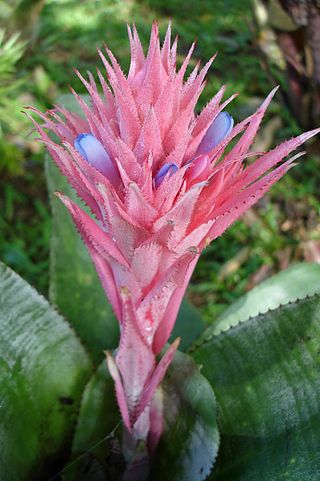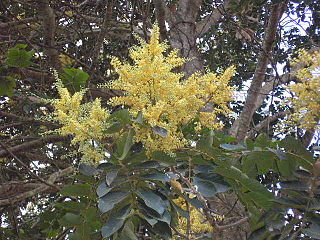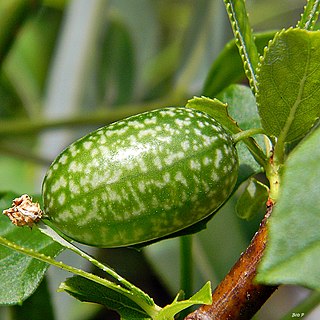
The Cucurbitaceae, also called cucurbits or the gourd family, are a plant family consisting of about 965 species in 101 genera. Those most important to humans are the following:

Melastomataceae is a family of dicotyledonous flowering plants found mostly in the tropics comprising c. 175 genera and c. 5115 known species. Melastomes are annual or perennial herbs, shrubs, or small trees.

Cucumis is a genus of twining, tendril-bearing plants in the family Cucurbitaceae which includes the cucumber, true melons, the horned melon, and the West Indian gherkin.

Sechium was a genus of plants now subsumed into the genus Sicyos: also placed in the tribe Sicyoeae of the gourd family, Cucurbitaceae. Its best known member was the edible and widely cultivated chayote.

Aechmea is a genus of flowering plants in the family Bromeliaceae. The name comes from the Greek aichme, meaning "spear". Suggested pronunciations include EEK-me-ə and eek-MEE-ə. Aechmea comprises eight subgenera and around 250 species distributed from Mexico through South America and the Caribbean. Most of the species in this genus are epiphytes.

Sicyos is a flowering plant genus of the family Cucurbitaceae. Members of the genus may be known as "burr cucumbers", but the genus includes Sicyos edulis which is the christophine or chayote.

Tachigali is a flowering plant genus in the legume family (Fabaceae). It includes 74 species of trees native to the tropical Americas, ranging from Nicaragua to Bolivia, Paraguay, and southern Brazil. Typical habitats include tropical rain forest, lower montane forest, seasonally-flooded and non-flooded evergreen lowland forest and woodland, gallery and riparian forest, sometimes on white sands, cerrado and other dry woodland, and rocky grassland.

Apodanthera is a genus of plants in the family Cucurbitaceae. It includes 25 species native to the southwestern United States, Mexico, and South America from Ecuador and eastern Brazil to northern Argentina.

Melothria is a genus of flowering plants in the family Cucurbitaceae, native to the Americas from the United States to Argentina, and with some introductions in Africa and elsewhere. A number of Old World species formerly in Melothria were reassigned to Cucumis.

Echinopepon is a genus of flowering plants in the family Cucurbitaceae, native to the southwestern United States, Mexico, Central America, and South America. Tendrillate vines, their prickly fruits are operculate, with the prickles themselves being stipitate glandular.
Hemsleya is a genus of flowering plants belonging to the family Cucurbitaceae.

Gurania is a genus of flowering plants belonging to the family Cucurbitaceae.
Pteropepon is a genus of flowering plants belonging to the family Cucurbitaceae.
Hanburia is a genus of plants in the tribe Sicyoeae of the gourd family, Cucurbitaceae. Its native range is from Mexico to Venezuela and Peru. It is found in the countries of Colombia, Costa Rica, Ecuador, Guatemala, Honduras, Mexico, Panamá, Peru and Venezuela.












